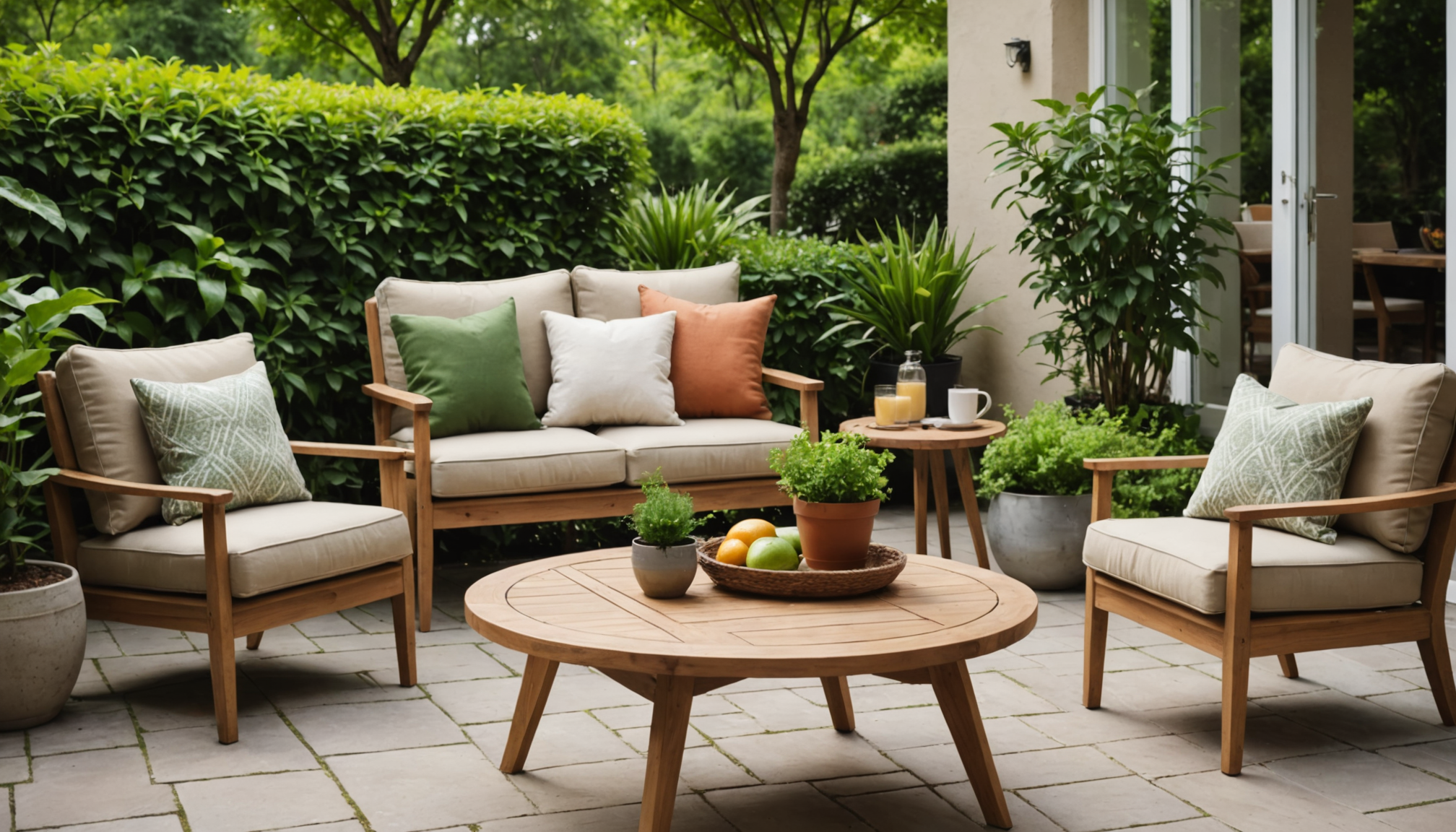Selecting the right furniture for your patio is crucial to creating an inviting, comfortable, and functional outdoor space. As you plan to decorate your patio, consider factors like material durability, size, style, and how you intend to use the space. With the right choices, your patio can become an extension of your living area that enhances your home’s value and appeal, which can be a significant advantage if you are ever in the real estate market.
Begin by considering the primary purpose of your patio. Is it a place for entertaining guests, enjoying family meals, or a quiet retreat for reading and relaxation? Determining the main use will guide you toward the right furniture types and arrangements.
Materials are paramount in selecting patio furniture. Consider the following options:
| Material | Pros | Cons |
| Wood | Natural beauty, warmth, and comfort. | Requires maintenance; may weather with seasonal changes. |
| Metal | Durable, strong, and can be styled in various ways. | Can rust if not treated; often heavy and not easily moved. |
| Plastic | Lightweight, affordable, and easy to clean. | Can fade or crack over time; less sturdy. |
| Wicker | Classic, lightweight, and generally weather-resistant. | May not withstand heavy use; some types need protection from extreme weather. |
The size and layout of your patio are also critical factors. Measure your space carefully and consider how much room you want for movement and additional features like planters or décor. Arranging furniture in groups can create distinct zones, such as a dining area or a lounging section, enhancing the functionality of the patio.
Style is another important consideration. Your patio furniture should harmonize with the overall aesthetic of your home and outdoor landscape. Whether your home exudes a classic colonial charm or an urban modern vibe, ensure your patio reflects this by choosing complementary designs and finishes. Neutral colors with simple lines suit most homes and offer flexibility when adding seasonal decorations or textiles.
Do not overlook comfort, especially if your patio serves as a hub for socializing or relaxation. Opt for furniture with plush cushions or ergonomic designs to encourage long stays and unforgettable gatherings. Choose textiles that are fade-resistant and water-repellent to withstand the elements while providing that homely comfort reminiscent of your living room or kitchen.
Additionally, furniture versatility adds an extra layer of practicality. Multi-functional pieces such as benches that provide storage or tables with extending leaves can maximize utility without sacrificing aesthetic appeal. This is not only efficient but also crucial for optimizing space in smaller patios.
Curated patio furniture can significantly enhance a property’s curb appeal, a valuable feature in the real estate market. From a resale perspective, well-appointed outdoor areas can make a lasting impression on potential buyers, transforming your patio into a vital selling point and possibly increasing your property’s market value.
Incorporating plants and greenery
When transforming your patio into a lush oasis, incorporating plants and greenery is an essential step. This not only enhances the visual appeal but also creates a tranquil environment that encourages relaxation. Here’s how you can effectively integrate plants and greenery into your patio decor:
1. Evaluate Your Space and Conditions:
– Assess your patio’s sunlight exposure. Different plants require varying amounts of sunlight, so identifying whether your space receives full sun, partial shade, or is mostly shaded helps choose the right plants.
– Consider the climate and seasonal changes in your region. Select plants that thrive in your local climate to ensure vibrant growth throughout the year.
2. Choose the Right Planters:
– Opt for a variety of planters in different sizes and materials. From traditional terra cotta to contemporary metal or lightweight plastic, the choice of planters can complement the style of your patio furniture.
– Utilize planters with adequate drainage to prevent overwatering, which can lead to root rot.
– Incorporate raised beds or vertical planters to utilize space efficiently and create visual interest through varying heights.
3. Select Suitable Plants:
– For a Mediterranean vibe, consider planting fragrant herbs like rosemary, lavender, or thyme, which can also be used in your kitchen.
– Tropical plants such as ferns or palms can evoke a resort-like feel, adding lush greenery to your space.
– If you prefer low-maintenance plants, succulents or cacti are great options that require minimal watering and care.
4. Integrate Seasonal Decor:
– Refresh your plant selection or move planters around as the seasons change. For instance, introduce colorful annuals like pansies or marigolds in spring, and switch to more robust plants in preparation for autumn.
– Use seasonal flowers and foliages to create a dynamic environment that evolves throughout the year, keeping the patio inviting year-round.
5. Create a Layout with Balance and Harmony:
– Arrange your plants to create zones or focal points on your patio. Place taller plants in the back or corners of seating areas to create natural privacy screens.
– Group plants with similar care needs together for ease of maintenance.
– Balance your greenery by interspersing plants with seating areas, allowing spaces for socializing while enhancing the aesthetic.
6. Add Decorative Elements:
– Incorporate garden sculptures or decorative pots that can serve as focal points or conversation starters.
– String lights or lanterns can be intertwined with larger plants or trees, providing enchanting lighting and drawing attention to your greenery after dusk.
By decorating your patio with meticulously chosen plants and greenery, you create a serene and inviting outdoor retreat. This thoughtful integration not only beautifies the space but also enriches your overall living experience, potentially adding value to your real estate should you decide to sell in the future.
Lighting for ambiance
Proper illumination can transform your patio into an enchanting and inviting space where guests love to linger long after the sun sets. Effective lighting not only enhances visibility but also adds a magical ambiance that makes the entire setting come alive. When planning your outdoor lighting, consider the various functions your patio serves and the mood you wish to create. A well-lit patio can significantly extend the usability of your space throughout the year, imparting warmth and charm during chilly winter months or balmy summer evenings.
Begin by examining the key areas that require illumination. Task lighting is essential for functional areas such as pathways, entrances, and stairs, providing safety and guiding guests smoothly around the space. Use strategically placed lights that highlight these elements without overwhelming them, allowing each feature to stand out naturally.
Ambient lighting is at the heart of creating a cozy and inviting atmosphere. This can be achieved using soft, diffused lights like fairy lights, lanterns, and LED strips. Drape string lights across pergolas or from trees to deliver a starry, whimsical effect over the seating area, transforming a simple patio into a captivating retreat. Lanterns, both decorative and functional, can be positioned beside furniture or hung at varying heights, contributing to a layered lighting scheme that accentuates the nook’s texture and tone.
Accent lighting further personalizes your patio by highlighting key features, such as unique architectural details, water features, or striking plants. Employ spotlights or uplights to accentuate these elements, enhancing their natural allure and adding depth to your outdoor design. This is particularly effective when balanced with the greenery established earlier, creating a dynamic interplay between light and shadow that enhances the patio’s ambiance.
Consider the use of solar-powered lights for an eco-friendly solution that harnesses sunlight during the day and shines beautifully at night. Such options are not only sustainable but also reduce energy costs, making them a smart investment for any eco-conscious homeowner. With easy installation and minimal maintenance, solar lights can be effortlessly repositioned to adapt to seasonal changes and evolving design preferences.
For a touch of elegance, integrate dimmable lights or those with color-changing capabilities. These can be adjusted to suit different occasions—whether a lively summer barbecue or a serene autumn dinner. Such flexibility allows your patio’s ambiance to flow seamlessly from day to night, ensuring that your outdoor space is always dressed perfectly for any gathering.
Incorporating smart lighting systems can also elevate your patio’s functionality. With the convenience of controlling lights via smartphone apps or voice commands, you can easily switch between different lighting scenes to match the occasion. This technology not only adds a modern flair but also enhances the convenience and versatility of your outdoor living area.
Properly selected and thoughtfully arranged lighting not only improves the aesthetics of your patio but also amplifies the overall experience of your outdoor space. Just as with interior design, embracing a blend of functional and decorative elements can enrich your real estate, potentially making it more appealing to families looking for a space that elegantly marries practicality and charm.
Choosing a color scheme
Color plays a vital role in setting the mood and character of your patio, transforming it into a personal haven that resonates with your individual style. Choosing the right color scheme involves more than just picking your favorite hues; it’s about creating harmony and visual interest that complement your outdoor space and its elements. Begin by considering the overall atmosphere you wish to evoke on your patio. Are you aiming for a serene, spa-like retreat, a vivacious party-ready space, or perhaps a rustic and cozy haven? The color palette will serve as the foundation for achieving this look.
Neutral tones such as whites, greys, and soft earth colors can create a sophisticated and timeless backdrop, allowing you to easily introduce seasonal accents through textiles and decor. These colors offer flexibility, making them particularly advantageous if you frequently update your patio’s look to align with real estate trends or personal preferences. Moreover, neutral shades seamlessly integrate with natural elements like plants and stone, enhancing the overall aesthetic without overwhelming the senses.
If your patio is meant to be an energizing and lively spot, consider brighter colors like blues, corals, or yellows. These hues can evoke the spirit of coastal or Mediterranean landscapes, bringing a zestful atmosphere to your outdoor gatherings. Splashes of vibrant colors can energize your space, creating a lively environment for socializing and entertaining. Use these vibrant tones as accents through cushions or artwork, ensuring they are balanced with more subtle shades to prevent visual fatigue.
Incorporating a monochromatic scheme can add an element of modern chic to your patio. Choose variations of a single color family to create depth and interest. This approach allows you to play with texture and shade without the risk of clashing colors. For instance, a range of greens can mimic the lush greenery of an English garden, providing a calming, nature-infused ambiance.
For those inspired by a rustic or farmhouse look, earthy colors like terracotta, deep reds, and forest greens can create a warm, inviting space reminiscent of a countryside escape. These color choices can beautifully resonate with wooden furniture and stone features, tying together the natural and built elements of your patio seamlessly. If your patio opens up from your kitchen or living area, consider carrying similar color themes from the interior to the exterior, creating a cohesive flow and extending your home’s living space outdoors.
While choosing your color palette, don’t forget to account for the architectural style of your home and existing outdoor features. A cohesive scheme that aligns with your home’s exterior, plants, or even your patio furniture will enhance the overall appearance, ensuring the space is both attractive and well-coordinated. Remember to consider the lighting when selecting colors, as natural light can dramatically change how shades appear at different times of the day.
Seasonal changes can also provide an opportunity to refresh your color scheme. Consider incorporating seasonal textiles like throws or pillowcases, enabling your patio to adapt from sunny summer days to chilly autumn evenings. By selecting a versatile base palette, you can easily highlight seasonal blooms or festive decorations, ensuring your patio remains appealing year-round. With a well-thought-out color scheme, your patio can truly shine, enhancing not only your personal enjoyment but also potentially increasing the appeal and value of your property in the competitive real estate market.
Accessorizing with textiles and decor
To further elevate the charm and functionality of your patio, integrating textiles and decor is an essential step. These elements not only add comfort and style but also enable you to express your personality and tailor the space to your needs. Begin by selecting cushions and throws that harmonize with your chosen color scheme. Opt for fabrics designed for outdoor use, which are both durable and resistant to fading. This ensures longevity, even in harsh sunlight or during sudden rain showers.
Rugs are an excellent way to define areas within your patio, such as seating or dining zones. Choose all-weather rugs that can withstand the elements while adding texture and warmth underfoot. The pattern and color of your rug can either complement or contrast with your furniture and other textiles, offering a focal point that anchors the entire design.
Consider the addition of outdoor curtains that not only add elegance but also provide privacy and shade as needed. These can be particularly beneficial for patios that are exposed to direct sunlight or those shared with neighbors. With a variety of materials to choose from, you can select sheer fabrics for a subtle, ethereal effect or heavier textiles for a more dramatic, enclosed space.
Decorative elements like lanterns and candle holders can enhance the mood and ambiance of your patio. Strategically place candles in varied heights and styles to create an inviting glow during evening gatherings. Incorporate curated collections of decor, such as ceramic vases, garden statues, or antique finds, to add character and uniqueness to your space.
Seasonal decor allows you to refresh your patio’s look with minimal effort. For fall, consider adding warm-toned throws and cushions, along with pumpkins or rustic centerpieces. In summer, lightweight linens and brightly colored accessories can infuse the space with energy and vibrancy. This approach not only keeps the area visually interesting but also aligns your patio with the changing seasons, much like you would update decor within your kitchen for seasonal gatherings.
By thoughtfully selecting and placing textiles and decor, your patio can become a true reflection of your style, serving as an extension of your home rather than a separate space. This cohesion can significantly boost the outdoor aesthetic, creating a sophisticated and inviting area that enhances your overall real estate appeal. Whether you’re hosting a casual barbecue or enjoying a quiet evening under the stars, the right decor will ensure your patio remains a cherished retreat for years to come.
In conclusion, transforming your patio into a beautifully decorated and functional space requires thoughtful consideration of furniture, plants, lighting, color schemes, and accessories. With these elements seamlessly integrated, your patio can become a cherished oasis that enhances both your lifestyle and property value. By adapting to seasonal changes and maintaining a cohesive design, your outdoor area will remain an inviting, dynamic space for relaxation and entertainment


